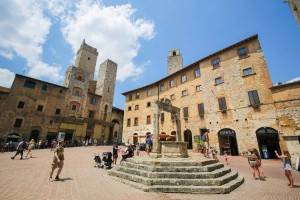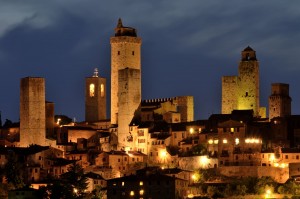A long drive through the hills of Tuscany on narrow roads with even narrower hairpin turns proves to be unbelievably nerve-racking, particularly when travelling in coach. While you’re still trying to catch your breath, San Gimignano pops up before your very eyes. The stunning small town is also known as “Medieval Manhattan” or “Town of Fine Towers” due to the 72 tower houses that used to adorn the medieval trading centre. Only 15 survived to this very day. San Gimignano’s entire historic centre was already declared UNESCO World Heritage Site in 1990 and provides gripping insights into days long gone. And don’t even get us started on what’s likely the best ice cream in the world…
The arms race of patrician families

©Bigstock.com/Jorisvo
The tremendous tower houses and equally enthralling palaces and churches are predominantly the result of the vanities of medieval patrician families stemming from an era heavily affected by repeated feuds and disputes. Those families tried to one-up each other constantly, particularly during times of conflicts and controversies in the 12th and 13th century. San Gimignano itself was a rich town. Its central location at the trade route Via Francigena plus the saffron cultivation and trade – saffron was used to dye silk fabrics – facilitated a boom period of 160 years that only ceased in the Late Middle Ages when drained swamps created easier routes rendering the Via Francigena mostly useless. San Gimignano sunk into poverty; later eras left hardly any marks.
Before all of that, however, massive towers rose into the sky leading to an arms race. These tower houses were originally intended for residential and protective purposes as the very limited space in San Gimignano prohibited wide-spread construction and led, quite literally, to dizzying heights. The functional outset quickly turned into something more prestigious. Once an adverse family had added another floor, one’s own tower house needed to be expanded or – even better – a new, even grander tower had to be built. However, these disputes also led to the destruction of numerous tower houses. In addition, the decay in later centuries and certain urbanistic projects caused the demolition of other formerly prime specimen. 15 tower houses remain in San Gimignano.
Tower houses and fortifications

©Bigstock.com/Jorisvo
Just to get this out of the way, we won’t name each and every sight that’s part of this impressive World Heritage Site, simply because there are far, far too many. Instead, we’ve prepared a few select highlights for you. Oh, and don’t forget to stop at one of the many ice cream parlours during your walk through the historic centre, because San Gimignano is home of genuine, award-winning ice cream world champions.
But that’s enough of the sweet, ice-cold treats for now (then again, can there ever be enough?) – here are some of the most beautiful tower houses and fortifications of San Gimignano:
- Torre Grossa: As mentioned, size actually mattered in the Middle Ages. Torre Grossa is part of the town hall ensemble Palazzo del Popolo. It is San Gimignano’s tallest tower house at a whopping 54 m.
- Torre Rognosa: Let’s go from the tallest to the oldest surviving tower. Torre Rognosa reaches an impressive 52 m and was likely built around 1200. Its small, covered terrace makes it one of the most beautiful and best-preserved tower houses.
- Torre Chigi: The intricate execution of the stone carvings, particularly the arches and windows, continues to amaze. Fitted precisely between medieval palaces, its beauty remains breath-taking to this very day.
- The city walls: Much like Rome, San Gimignano’s fortifications weren’t built in a day. The walls were constructed in two phases and stretch across a total of almost 2.2 km. The first part was mounted around 998, the remainder followed during the 13th and 14th San Gimignano is currently accessible via five massive town gates with Porta San Giovanni assuming a key role. It used to house a small church that was demolished in 1922 for lack of space. The bell tower, however, survived.
Palaces and museums
That’s it for the town houses and walls, at least for a few lines. Don’t miss out on the following palaces, castles and museums in the historic centre of San Gimignano that are most definitely must-see:
- Palazzo del Popolo: This building, also known as Palazzo Comunale, currently houses the town hall and is flanked by the massive Torre Grossa. Additionally, both a stunning museum and an art gallery are hidden behind the beautiful façade with its arched windows made of stone and brick. Look forward to seeing numerous fresco decorations and paintings of famous citizens.
- Palazzo del Podestà: Next up is the former town hall lined by the fabulous Torre Rognosa. Both buildings are only a few steps apart. The characteristic mix of stone and brick, complemented by the large archway, emits rustic charm. Several works by Giovanni Antonio Bazzi, also known as Sodoma, can be seen above the entrance of the large hall.
- Palazzo Pratellesi: This splendid example of grand architecture virtually glows thanks to its terracotta arches. If you’re lucky, you might see a stunning fresco by Vincenzo Tamagni inside the palace.
- Galleria continua: Not everything in San Gimignano is about the past. The town is also home to one of the most important Italian galleries of contemporary art. Regionality meets international flair.
- SanGimignano1300: If you’ve ever wondered what life inside the medieval town was some 700 years ago, this ten-part exhibition is the place to be. The 3d replicas of the former historic centre are particularly stunning. They show buildings that were destroyed centuries ago as well as emulations of Memmo di Filipuccio’s frescoes that used to grace Palazzo del Podestà.
San Gimignano’s churches
What would San Gimignano be without its churches? Countless religious buildings form yet another piece of the town centre puzzle. Time for a final look at our top suggestions for your World Heritage Site tour:
- Collegiata Santa Maria Assunta: This church played a key role in the compilation of this very World Heritage Site. The UNESCO specifically highlighted the outstanding beauty of the frescoes. As such, you’ll find a richly decorated marvel behind the simple Romanesque façade. Several fresco cycles – dedicated to the Old Testament, New Testament and Last Judgement among other things – glow with an astonishing blaze of colours. Don’t sleep on the Renaissance chapels.
- Sant’Agostino: San Gimignano’s second-biggest church looks massive, even monumental. The enormous 13th century building dominates a big part of the historic centre. Look out for the 17-part fresco cycle dedicated to the life of Saint Augustine. Capella di San Bartolo harbours the mortal remains of the eponymous saint.
- San Jacopo al Tempio: A closer look behind the walls made of brick and travertine unearths numerous art treasures. The one-nave church houses breathtakingly beautiful frescoes by Memmo di Filipuccio and Pier Francesco Fiorentino. Nowadays the building belongs to the nuns of San Girolamo. A covered overpass connects their convent with the church.
There are only few other places in the world offering as much excellently preserved medieval architecture in one space as the historic centre of San Gimignano. This tour across sweeping squares and through narrow alleys introduces you to a wildly fascinating era. Don’t forget to sit down every once in a while – while enjoying the best ice cream in the world, obviously – and let the unique atmosphere of the old walls sink in.